RECOIL OFFGRID Gear EDC Flashlight Review
In This Article
Summer is officially here, and with it comes a natural variation in wardrobe. Warmer weather leads to lightweight clothing and increased physical activity, neither of which is conducive to pockets crammed full of gear. It’s for this reason that many of us pare down our everyday carry slightly for this season. Maybe that means you start carrying a single-stack subcompact handgun instead of a double-stack full-size, or a lightweight folding knife instead of something more robust. What it shouldn’t mean is that you start leaving behind the essentials. Murphy’s Law dictates the moment that happens is the moment you’ll need those items the most. A EDC flashlight is one such essential tool.
The light in your pocket will help you figure out what the heck your dog keeps barking at in the backyard, find the pen that fell between the seats of your truck, and read the menu in your spouse’s favorite obnoxiously dim restaurant. And unlike a keychain light or the tiny LED on your cell phone, it can provide the focused illumination you need to clear your house if you come home to a door that’s unexpectedly ajar.
However, flashlights can get heavy and bulky, so we decided to compare seven models that can fit into even the smallest pockets. One key constraint was that each of these lights must run on a single CR123 battery. Most of our typical EDC lights are powered by two of these batteries, so we already have plenty of spares on hand, making the seasonal transition easier. If swapping gear out becomes a hassle, you’ll be more prone to leave it at home, so interchangeability is an important consideration.

Read on as we evaluate seven single-CR123 flashlights to determine which might fit your minimalist EDC loadout.

Notes: This light serves as a replacement to the discontinued 5.11 Tactical TMT L1, which produced 212 lumens from a Cree XPG-B LED. Using a newer Cree XP-L2 V5 LED, the Rapid L1 now offers 290 lumens, and also features a revised switch design and shorter overall length. However, comparing the lights side-by-side, the Rapid looks almost identical, aside from the new name, different tail cap, and some extra texture around the head.
The updated switch is a big improvement over the old TMT series and is now much easier to press with a nice tactile click feel. Raised guards on each side protect it from accidental presses, although we feel these could’ve been shorter and more rounded for improved comfort. Output is 290 lumens on high and 19 on low, with an additional high-power strobe function. The beam pattern appears as a soft spotlight with a subtler flood pattern around the periphery. Unfortunately, the output has a noticeable blue tint, which causes it to appear substantially less powerful than the other lights in this guide. We’ve found this to be a common problem among inexpensive flashlights, and once you learn to recognize it, it’s hard to overlook.
We’ve had plenty of great experiences with 5.11 Tactical packs, apparel, and other products, so it’s unfortunate that this updated light design still feels a few steps behind the competition. It’s definitely an improvement on the old TMT, but it’s far from cutting-edge.


Dimensions: 3.5 by 1.0 inches
Claimed Max Output: 290 lumens
Claimed Max Runtime: 2 hours 7 minutes
Weight with Battery: 2.5 ounces
Output Modes: High, low, strobe
MSRP: $50
URL: www.511tactical.com
Pros:
>Aluminum body feels tough and is rated IPX7 water-resistant to 1 meter immersion
> Tail cap switch is easy to use to cycle through modes and gives a positive click for constant activation.
Cons:
> Strong bluish tint makes the output feel dimmer than it actually is
> Tail cap is sharper and more aggressive than the bezel, so using it as an impact weapon is more likely to hurt your thumb than an attacker
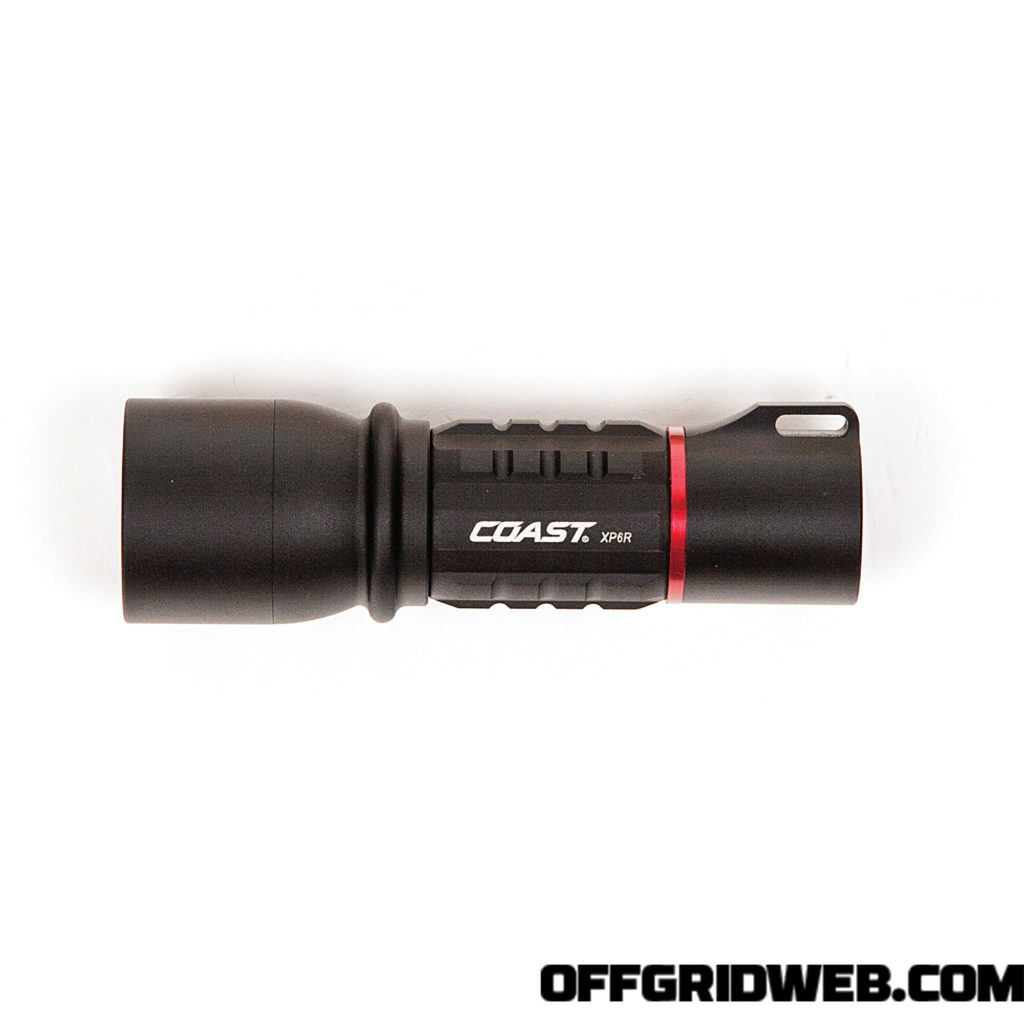
Notes: After seeing the brand-new XP6R at SHOT Show in January, we immediately wanted to get our hands on one. When we started working on this article, the production version of the light wasn’t quite ready, but Coast kindly sent us this pre-production prototype. It’s part of a new XP Series of flashlights and will accept a Coast Zithion X rechargeable battery (included) or a single CR123 (not included). Based on the generic blue battery that arrived with the prototype XP6R, it looks like Zithion X will be Coast’s private-label 3.7V 650mAh 16340 battery with a built-in micro USB port. As you might expect, output is visibly reduced when using a CR123, dropping from a maximum of 480 lumens to 290 lumens.
As with many other Coast lights, the XP6R features the company’s signature slide-focusing optic, which lets the user rearrange output from a tight spot to a wide flood pattern by moving the head back and forth with a thumb. This is especially helpful for map reading and other close-up tasks where a spot beam would be detrimental. If most of the items you need to illuminate are within arm’s reach, the XP6R has a clear advantage over the other lights in this guide. Low, medium, and high modes are cycled with each press of the tail cap switch, but no memory function is present, so each time you turn it on, you’ll have to click the button a few times to select the appropriate output. This light is expected to go on sale in the fourth quarter of 2020.


Dimensions: 3.6 by 1.1 inches
Claimed Max Output: 480 lumens (see notes)
Claimed Max Runtime: 15.5 hours
Weight with Battery: 2.6 ounces
Output Modes: Low, medium, high
MSRP: $40
URL: www.coastportland.com
Pros:
The slide-focusing optic offers outstanding versatility. We’ve always been a fan of this feature on Coast’s flashlights.
Nice ergonomics and aesthetics, from the knobby machined ridges on the body to the anodized trim ring and sculpted lanyard hole
Cons:
It lacks a pocket clip, and that’s practically a deal-breaker for us in this category. Carrying a flashlight loose in a pocket makes it harder to access and easier to activate by accident.
No mode memory — this means that if you turn off the light in high mode, it’ll turn back on in low mode next time, then medium the following time.

Notes: This impressively tiny light is the smallest in our guide by a substantial margin, with dimensions that are comparable to a USB flash drive or mini BIC lighter. Despite this, it packs in an impressive amount of features. There are four brightness levels, ranging from 5 to 750 lumens, plus a strobe function. There’s a side activation button with a battery indicator LED in the middle, and a lockout function to prevent accidental activation (double-click the button to toggle lockout). On the opposite side of the head, you’ll find a circular charging contact that attaches to the included magnetic USB cable. The light’s tail cap also contains a magnet, so it can be stuck to surfaces such as a toolbox or car hood for hands-free illumination. A removable pocket clip and lanyard are also included.
Although the E18R can be powered by a standard CR123 battery, the magnetic charging function only works with the included Fenix 3.6V 16340 battery or similar models with integrated protection circuits. A standard or rechargeable CR123 “can be used for emergency,” according to the manual, but lumen output will be reduced. Additionally, plugging in the magnetic charger while one of these batteries is installed could cause a fire or explosion. Thankfully, the power button LED clearly indicates charge status ranging from full (green) to critical (red flashing) so you’ll know when it’s time to swap out or plug in.
If you’re heading out in gym shorts and a T-shirt with a bare minimum amount of gear, but still want to carry a flashlight, the E18R is a great choice. It’s about as small as you can get before you leave the realm of pocket flashlights and start looking into micro keychain lights.

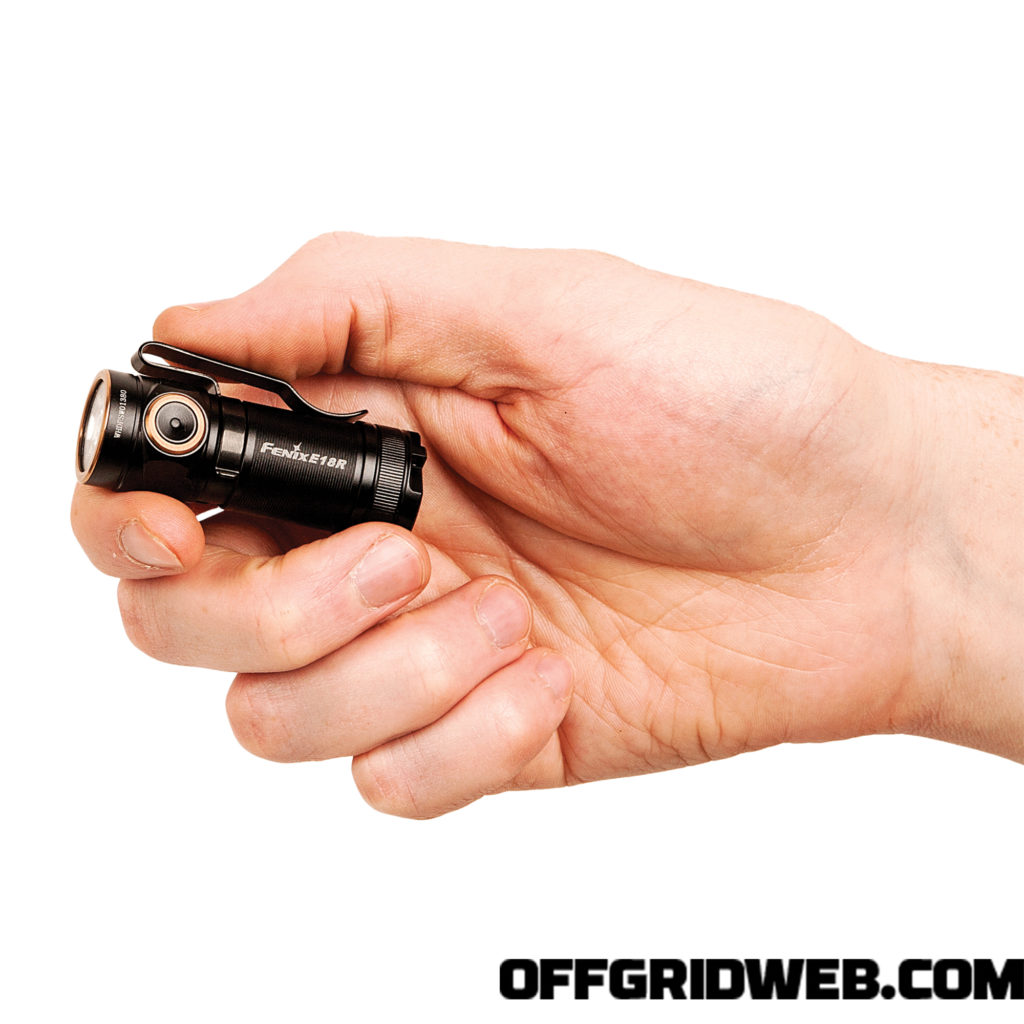

Dimensions: 2.4 by 1.0 inches
Claimed Max Output: 750 lumens (see notes)
Claimed Max Runtime: 70 hours
Weight with Battery: 1.8 ounces
Output Modes: Low, medium, high, turbo, strobe
MSRP: $65
URL: www.fenixlight.com
Pros:
> Compact design isn’t much larger than the battery it contains, yet crams in a surprising list of features
> The magnetic charger provides a convenient way to make sure your light is always topped off and ready to go. It works great in a car USB port, too.
Cons:
> The small, side-mounted activation button and similarly shaped magnetic charging contact can lead to some clumsy fumbling while trying to turn on the light.
> If the special magnetic cable is lost or misplaced, finding a replacement will be a hassle.

Notes: At most companies, engineers work within specific constraints and budgets set by project managers. At HDS Systems, the engineer runs the company. This is clearly evident in every aspect of the EDC Tactical light, starting with its straightforward name and no-frills knurled aluminum body. Its only identifying marks are the brand name and serial discreetly engraved on the bezel in a plain font. But like a Swiss watch, there’s an obsessive degree of attention to detail beneath the surface.
The light’s key feature is its rotary control mechanism. Twisting the tail cap adjusts between 24 constant brightness settings, momentary strobe, and momentary full output; each is activated via a satisfyingly crisp click switch. Rather than performing occasional quality control checks like most manufacturers, HDS Systems manually calibrates every light to its exact lumen rating in-house. The company’s website offers detailed descriptions of components, including the PVD antireflective lens coating, black-nitride-coated stainless bezel, trapezoidal Acme threads, proprietary constant power LED regulation system, and custom software that has gone through nearly two dozen revisions (ours has version 2.18). When was the last time you thought about the software version your flashlight is running?
The EDC Tactical comes with a four-page user guide, but there’s a downloadable 20-page advanced guide that’ll teach you how to unlock its many programmable functions. If that’s not enough, you can custom-order a light with a variety of LED types, battery types, and other features such as a sapphire crystal (!) instead of glass. There’s even a limited-production C173 beryllium copper body option that brings the light’s price to more than $1,000. No, that wasn’t a typo — one thousand dollars.

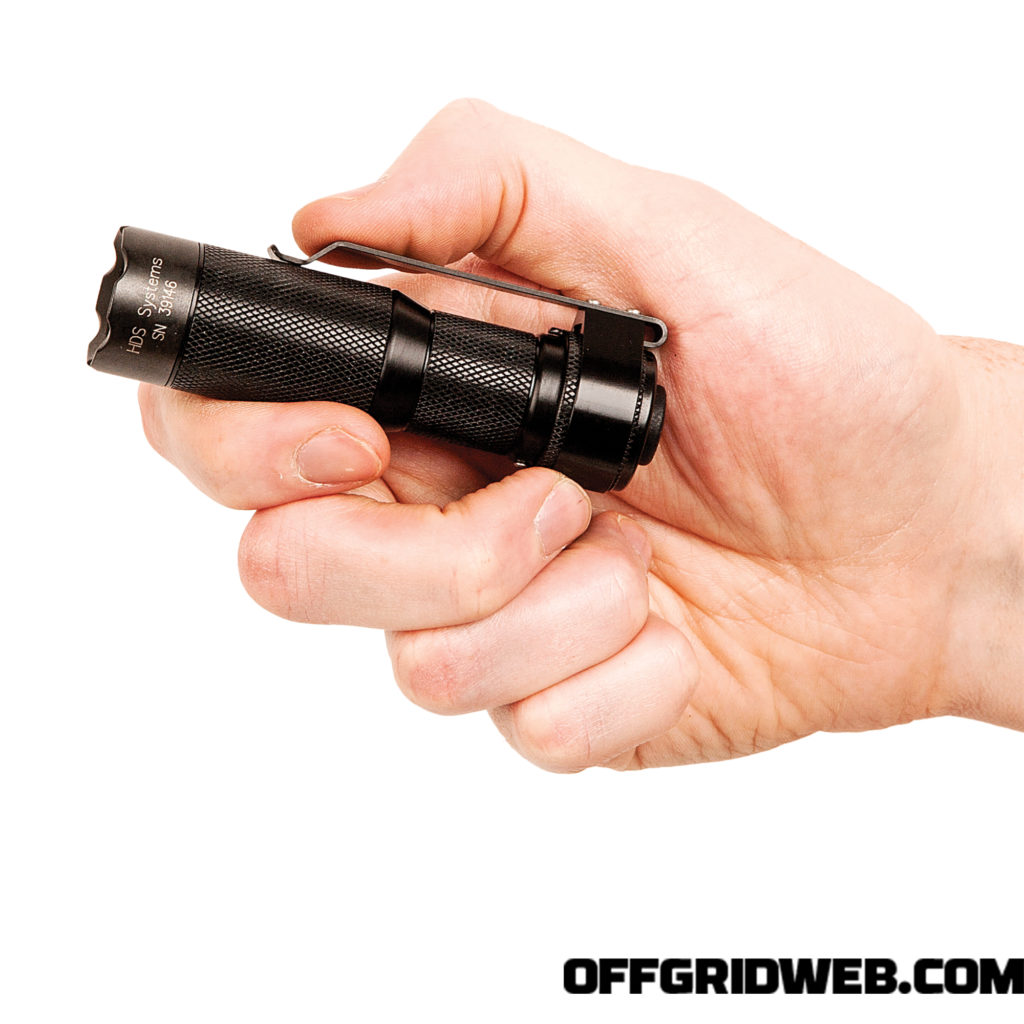

Dimensions: 3.9 by 1.0 inches
Claimed Max Output: 325 lumens
Claimed Max Runtime: 121 hours
Weight with Battery: 3.7 ounces
Output Modes: Constant-on with 24 brightness level increments, momentary maximum, momentary strobe
MSRP: $314
URL: www.hdssystems.com
Pros:
> With tight tolerances, tactile controls, and extreme attention to detail, this light exudes quality in a way that’s hard to convey on paper.
> If you’re the type of person who has strong feelings about CRI and beam pattern, and frequently gets into debates on flashlight forums, this might be the light you always wanted.
Cons:
> Lacks a built-in pocket clip — the slip-on clip seen here is an optional accessory and not an ideal retention solution because of the rotary control scheme.
> Although we understand the reasons for the premium price, it’s likely to deter all but the most diehard lighting enthusiasts from purchasing this product.

Notes: The EC11 accepts a CR123 battery, but after using it, that starts to feel like an afterthought. The first sign of this is the spec sheet, which shows that the light produces 900 lumens with a Nitecore IMR 18350 3.7V battery, but 430 lumens with a regular 3V CR123. Additionally, the battery compartment contains a removable plastic spacer that serves to prevent a slightly narrower CR123 battery from rattling around. This wouldn’t bother us if the light came with an 18350 battery by default, but it doesn’t. That battery requires a separate charging cradle if you don’t have one already. Nitecore offers these two optional items for $17 with the purchase of this flashlight, effectively bringing the price to $77.
If, like us, you didn’t buy the Nitecore battery, you’ll need to be careful what you use. Various standard 3V CR123s worked fine, but at diminished brightness as expected. The Coast light’s unbranded 3.7V 16340 battery also worked properly and appeared to produce higher lumen output. However, a Fenix 3.6V 16340 and (more surprisingly) Nitecore’s own NL166 3.7V rechargeable CR123 yielded strange results. Cycling through modes appeared to eliminate low and medium — the light went from ultralow straight to high, then two more identical high settings, and finally turbo.
The EC11 offers a secondary red LED with constant and signal flash modes; it can also display battery power status “when out of the door” [sic]. If you see a pattern of two flashes, a pause, and eight flashes, that indicates 2.8V. The white LED features constant, strobe, SOS, and slow-flashing location beacon functions.


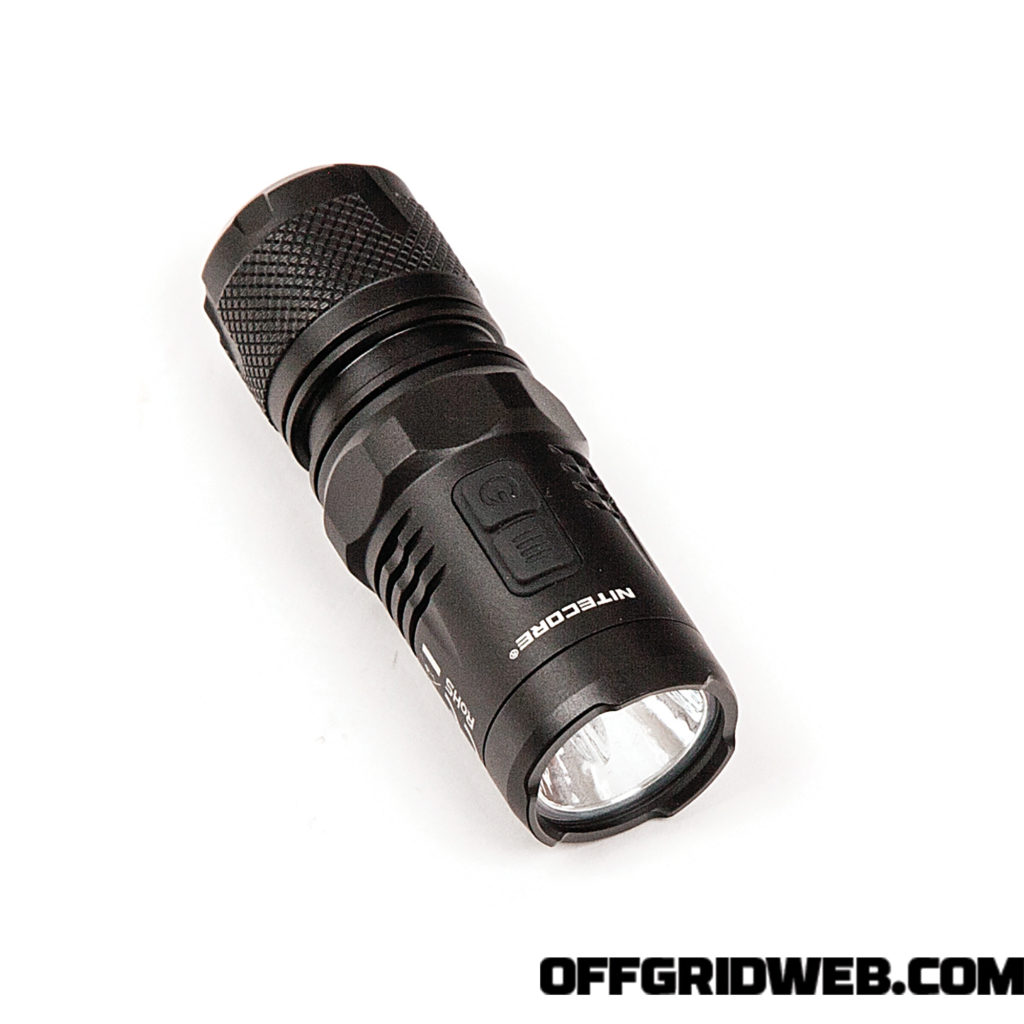
Dimensions: 3.0 by 1.0 inches
Claimed Max Output: 900 lumens (see notes)
Claimed Max Runtime: 12 hours
Weight with Battery: 2.3 ounces
Output Modes: Ultralow, low, medium, high, turbo, strobe, SOS, slow flash; secondary red LED
MSRP: $60
URL: www.nitecore.com
Pros:
> Red LED is a nice addition, especially with its ability to serve as a battery voltage gauge
> 430 lumens is bright enough for most purposes, but …
Cons:
> … the EC11 is boldly advertised at 900 lumens. Unless you spend extra for a special Nitecore IMR 18350 battery, you won’t be able to reach that maximum output.
> Testing revealed it to be very picky about power sources. Several brightness modes didn’t function correctly with some types of rechargeable CR123/16340 batteries.

Notes: As much as we appreciate the power and reliability of the CR123 battery for our EDC flashlights and weapon lights, we still recognize that it has some downsides. The biggest among those is availability. You can’t always walk into a gas station or corner store and know that you’ll be able to buy a spare. That’s certainly not the case with AA batteries, which are sold virtually everywhere. Recognizing this, Streamlight made a flashlight that takes either 1L (lithium CR123) or 1AA.
AAs and CR123s provide completely different levels of juice — 1.5V and 3V, respectively — and this has a direct effect on lighting performance. With a CR123, the 1L-1AA can produce 350 lumens for 1 hour and 30 minutes; with an AA alkaline battery, it’ll only produce 150 lumens for 1 hour and 20 minutes. For this reason, the former will be our primary power source, and the latter is a fallback option. Still, we’re thankful for it.
This light is constructed from solid aluminum finished in either black or coyote tan (pictured). It offers three modes, each of which can be activated in constant or momentary fashion. Streamlight’s Ten-Tap system allows the user to choose high/strobe/low, high only, or low/high configuration. Each light includes one of each type of battery, a removable pocket clip, and a nylon belt holster. Real-world prices for Streamlight products are often well below MSRP, and this is no exception. It can be found for less than $40 online, making it an excellent value.



Dimensions: 4.3 by 1.0 inches
Claimed Max Output: 350 lumens
Claimed Max Runtime: 14 hours
Weight with Battery: 2.4 ounces
Output Modes: Low, high, strobe
MSRP: $68 (see notes)
URL: www.streamlight.com
Pros:
> Compatibility with AA alkaline or lithium batteries is a huge advantage from a survivalist perspective, and provides a backup power option if resources are scarce
> 350-lumen high mode and 40-lumen low mode offer enough versatility for close- and medium-range tasks
Cons:
> Prior experience has taught us that these Streamlight pocket clips have a tendency to loosen and pop off.
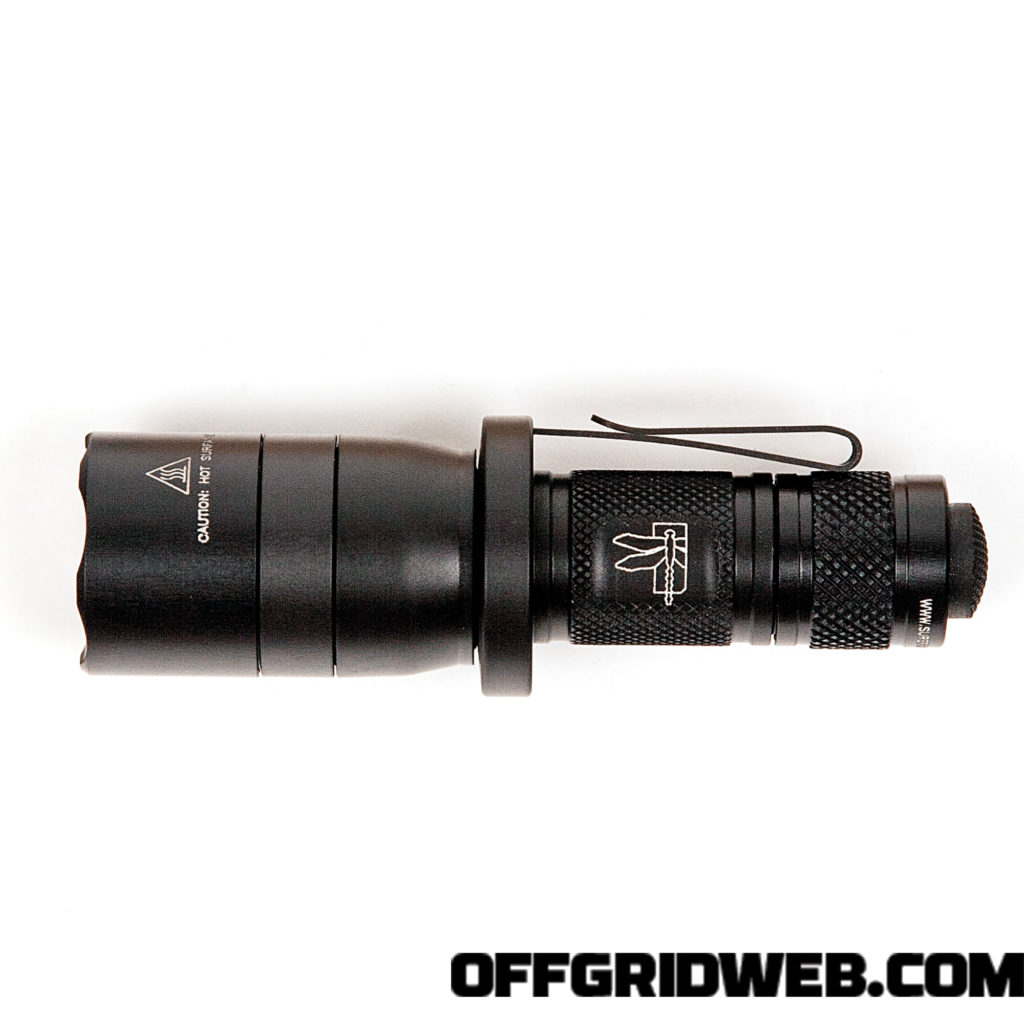
Notes: This light was conceptualized by Haley Strategic Partners, the company founded by Force-Recon-Marine-turned-shooting-instructor Travis Haley, and manufactured by SureFire. Its D3FT designation stands for Disruptive 3nvironments Firefly Technique (we’re not entirely sure what a threenvironment is). In a video on the company’s YouTube channel, Haley explains that its name is pronounced “deft,” as in “neatly skillful and quick in one’s movements.”
Regardless of these elaborate naming conventions, the D3FT’s design has an interesting logic behind it. It features a sturdy aluminum ring between the head and battery compartment, which is intended to be used alongside a handgun in the SureFire/Rogers grip — this involves placing the light between the index and middle fingers of your support hand, then pulling it back into a closed fist to depress the tail cap switch using the heel of your palm. This feels slightly awkward at first if you’re used to a thumb-on-tail-cap “icepick” grip, and may not work as well for those with smaller hands or less grip strength, but we quickly got the hang of it.
Functionally, the D3FT is about as simple as it gets. There’s one brightness level, which can be activated in momentary mode with a partial press or constant mode with a full click. Loosening the tail cap serves as a lockout. The beam is focused into a fairly dense spot pattern, comparable to other SureFire weapon-oriented lights like the EDCL series or E2D.



Dimensions: 4.1 by 1.3 inches
Claimed Max Output: 500 lumens
Claimed Max Runtime: 1 hour
Weight with Battery: 3.3 ounces
Output Modes: High only
MSRP: $169
URL: haleystrategic.com
(not available directly from SureFire)
Pros:
> The combination of aggressively knurled body, full-fist length, and central grip ring make this light easy to retain and manipulate.
> Its tail cap offers the perfect degree of springy responsiveness for reliable momentary or constant activation.
Cons:
> We like the pocket clip’s stiffness, but its leading edge is almost completely flat. This made the D3FT difficult to slip back into a pocket one-handed, especially with thick-stitched jeans.
> Single output and 1-hour runtime make this much better as a combat light than a utility light
 STAY SAFE: Download a Free copy of the OFFGRID Outbreak Issue
STAY SAFE: Download a Free copy of the OFFGRID Outbreak Issue
No Comments